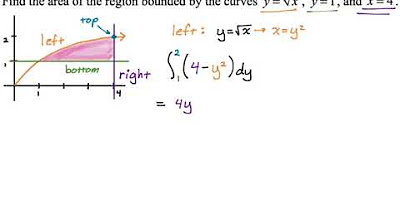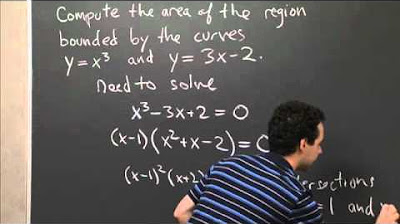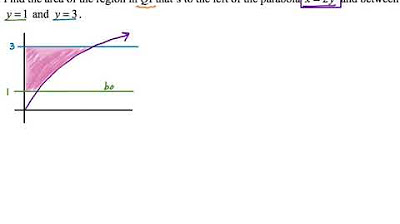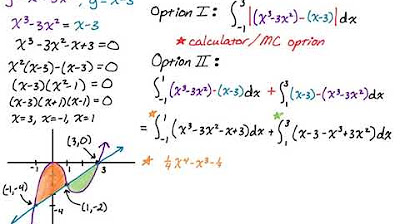Finding a Horizontal Line (y=k) to Divide a Region into Two Equal Parts Using Calculus
TLDRIn this video, the presenter tackles a calculus problem involving finding a horizontal line y = K that equally divides the area between y = x^2 and y = 9. The approach begins with visualizing the region and identifying the intersection points at x = ±3. The total area under y = x^2 from x = -3 to x = 3 is calculated using integration, resulting in 36 square units. Next, the presenter explores two methods to find the value of K. The first method involves integrating with respect to x from the bounds -√(K) to √(K), using symmetry to simplify the calculation, and solving for K to find it equals 27^(2/3). The second, deemed more straightforward by the presenter, integrates with respect to y, considering x as √(y) and -√(y), and solving the resulting integral to again find K as 27^(2/3). The video concludes by emphasizing the utility of integrating with respect to y for certain problems, offering viewers two effective strategies for solving calculus area problems.
Takeaways
- 📐 The problem involves finding a horizontal line y = K that divides the area between y = x^2 and y = 9 into two equal parts.
- 🔍 The video begins by suggesting the use of a figure to visualize the problem and understand the region to be divided.
- 🏁 Intersection points of y = x^2 and y = 9 are at x = -3 and x = 3, which are used as bounds for the integrals.
- ⚖️ The total area under the curve y = x^2 from x = -3 to x = 3 is calculated to be 36 using symmetry and integration.
- 🔑 The area under the curve y = K from x = -√K to x = √K is set to be half of the total area, which is 18, to find the value of K.
- 🧮 The integral for the area under y = K is evaluated using symmetry and the reverse power rule, leading to an equation in terms of K.
- 🗜️ Simplifying the equation results in K^(3/2) - (1/3)K^(3/2) = 9, which is then solved for K.
- 💡 The solution for K is found to be (27/2)^(2/3), which is the value that divides the region into two equal parts.
- 🔄 An alternative method is presented, integrating with respect to y, using x = √y and x = -√y as the bounds for the integral.
- 📈 The integral with respect to y is easier to handle and results in a simpler equation: 4/3 * K^(3/2) = 18.
- 📊 The final value of K is the same using both methods, demonstrating the versatility in solving calculus problems.
- 🎓 The video emphasizes the importance of being comfortable with both dx and dy methods in calculus as they can simplify different types of problems.
Q & A
What is the primary goal of the video?
-The primary goal of the video is to use calculus to find a horizontal line y = K that divides the area between y = x^2 and y = 9 into two equal parts.
Why is it helpful to start with a figure when solving this problem?
-Starting with a figure helps visualize the problem, understand the region to be divided, and identify the intersection points between y = x^2 and y = 9.
What are the intersection points of y = x^2 and y = 9?
-The intersection points are at x = -3 and x = 3.
How does one find the total area of the region between y = x^2 and y = 9?
-The total area is found by integrating from -3 to 3, using the top curve y = 9 and the bottom curve y = x^2, and applying symmetry to simplify the calculation.
What is the result of the total area calculation?
-The total area is 36 square units.
How does one find the area of the region below the horizontal line y = K?
-The area is found by integrating from the bounds -√K to √K with the top curve y = K and the bottom curve y = x^2.
What is the equation that represents the area below the horizontal line y = K?
-The equation is 2/3 * K^(3/2) - 1/3 * K^(3/2) = 9, after applying symmetry and simplifying.
What is the value of K that divides the region into two equal parts?
-The value of K is (27/2)^(2/3).
What is the alternative approach to solving the problem by integrating with respect to Y?
-The alternative approach involves considering x as a function of y (x = √y and x = -√y) and integrating from 0 to K with the integrand (√y - (-√y)) or 2√y.
How does the integration with respect to Y simplify the problem?
-Integrating with respect to Y simplifies the problem by avoiding dealing with the square root of K directly and using the power rule more straightforwardly.
What is the final equation obtained by the alternative integration method?
-The final equation is 4/3 * K^(3/2) = 18, which is used to find the value of K.
Why is it beneficial to think in terms of dy when solving calculus problems?
-Thinking in terms of dy is beneficial because it can simplify the process of integration, especially for problems where the integration variable is more naturally expressed in terms of the dependent variable.
Outlines
📐 Calculus Problem: Dividing an Area into Equal Parts
The video begins with an introduction to a calculus problem that involves finding a horizontal line y=K that divides the area between y=x^2 and y=9 into two equal parts. The presenter suggests starting with a visual representation of the problem for clarity. The intersection points of y=x^2 and y=9 are identified as -3 and 3, and a new line y=K is introduced to split the area equally. Two different methods are proposed to solve the problem. The first step in both methods is to calculate the total area under the curve y=9 minus the area under y=x^2 from -3 to 3. Using symmetry, the integral is simplified and evaluated to find the total area is 36 square units. The video then moves on to finding the area under the curve y=K, which is done by setting up an integral with bounds determined by the points where x^2 equals K. The integral is evaluated by using symmetry and the power rule, leading to an equation that is solved for K, yielding K = (27/2)^(2/3). The presenter also discusses an alternative method of integrating with respect to Y, which is considered a more straightforward approach by some, and involves integrating from 0 to K and solving for K using a similar process.
🧮 Alternative Integration Method: Integrating with Respect to Y
The second paragraph introduces an alternative approach to solving the calculus problem by integrating with respect to Y. This method is presented as potentially easier for some viewers, as it involves integrating the area under the curve from 0 to K, considering x as a function of Y (x = √Y and x = -√Y). The integral to be solved is ∫ from 0 to K (Y^(1/2) - (-Y)^(1/2)) dY, which simplifies to 2/3 * Y^(3/2) evaluated from 0 to K. Setting this equal to half of the total area (18), the presenter applies the power rule in reverse to find K. After evaluating the integral and simplifying, the solution for K is found to be the same as in the first method, K = (27/2)^(2/3). The presenter emphasizes the usefulness of integrating with respect to Y, as it can make certain problems more manageable.
Mindmap
Keywords
💡Calculus
💡Horizontal Line
💡Area
💡Integration
💡Intersection Points
💡Symmetry
💡Power Rule
💡Bounds
💡Definite Integral
💡Reverse Power Rule
💡dy
Highlights
The video uses calculus to find a horizontal line that divides a region into two equal parts.
The problem involves finding the line y = K that splits the area between y = x^2 and y = 9 equally.
A visual representation of the problem is recommended to understand the region's division.
Intersection points of y = x^2 and y = 9 are at x = -3 and x = 3.
The total area of the region between y = x^2 and y = 9 is calculated using integration.
Symmetry is used to simplify the calculation of the total area.
The integral from -3 to 3 of (9 - x^2) with respect to x is evaluated.
The total area is found to be 36 square units.
The area under the curve y = x^2 and above the line y = K is expressed in terms of K.
The intersection points where x^2 = K are found to be ±√K.
The area under y = K and above y = x^2 is calculated using integration from -√K to √K.
The area under y = K is set to be half of the total area, which is 18.
Integration with respect to Y is introduced as an alternative method.
The region is re-visualized with x = √y and x = -√y for integration with respect to Y.
The integral from 0 to K of (√y - -√y) with respect to y is evaluated.
The integral simplifies to 2/3 times K to the three-halves, which equals 18.
Solving for K, the value is found to be 27/2 to the 2/3.
Two different approaches to solving the problem are demonstrated.
The video emphasizes the importance of using calculus and symmetry in problem-solving.
The skill of integrating with respect to Y is highlighted as beneficial for certain types of problems.
Transcripts
Browse More Related Video

Area Between Curves: Integrating with Respect to y (Example 3)

Area Between y=x^3 and y=3x-2 | MIT 18.01SC Single Variable Calculus, Fall 2010

Area Between Curves: Integrating with Respect to y (Example 2)

Area Between Curves: Integrating with Respect to y (Example 1)

2012 AP Calculus AB Free Response #2

Area Between Two Curves with Multiple Regions: y = x^3-3x^2 and y = x-3
5.0 / 5 (0 votes)
Thanks for rating: